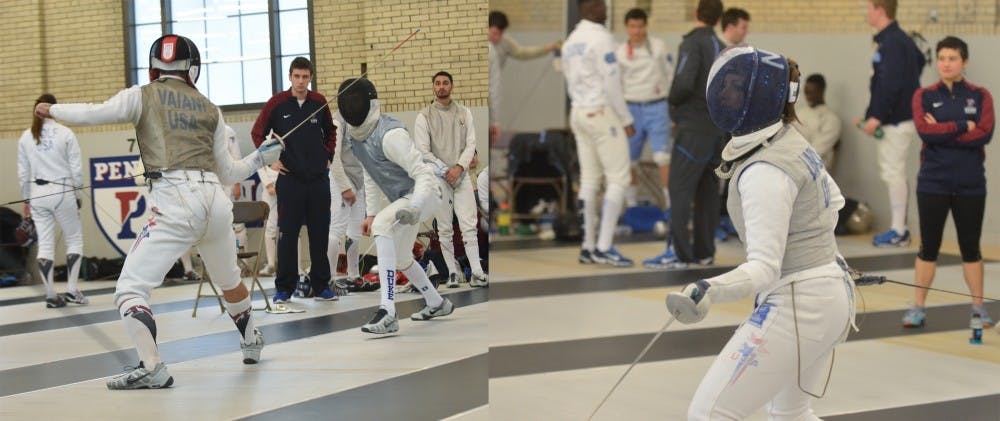
As captains in their respective events, senior men's foil John Vaiani (left) and junior women's foil Simone Unwalla (right) exemplify the versatility that Penn fencing is proud of.
Credit: Lizzy MachielseThree-for-one deals are never bad.
That is what fencing fans get whenever they watch a match. Though a first-time spectator or casual fan may have trouble noticing the differences, fencing’s three forms — sabre, epee, and foil — are all very nuanced.
Both Penn men’s and women’s fencing compete at a high level in all three categories. However, most fencers succeed in each form at some point in their careers.
At a young age, most fencers start off in foil. Fencers will then either continue with foil or switch to sabre or epee depending on their coaches' recommendations.
A foil sword weighs less than a pound and valid targets include the torso: from shoulders to groin in the front, and shoulders to waist in the back. An epee sword is heavier, weighing 27 ounces, but the whole body is a valid target. Lastly, sabre is the lightest sword and points can be registered from all parts of the blade. Additionally, the target area is the entire body above the waist, including the head.
“Sabre I would say requires more athleticism, epee focuses more on very precise point control, and foil is between the two,” coach Andy Ma says. “Every weapon has a different characteristic, like long jumping versus high jumping in track.”
Adding on, junior sabre Raphael Van Hoffelen classified epee as enduring, sabre as explosive, and foil as very technical.
Given the different styles, Penn has a coach that specifically focuses on each fencing style. Ma focuses on sabre, while assistant coaches Slava Danilov and Adi Nott focus on epee and foil, respectively. On the recruiting trail, Ma is involved in recruiting all three types of fencers. However, in epee and foil, he sends tape to his assistants for further evaluation. When it comes to epee and foil, he will collaborate more with his assistants when deciding who to recruit.
As a team in practice, all three forms warm up and do conditioning together in addition to post-practice stretching. In between, for most of each practice, each weapon group breaks off to focus on its own form and technique.
In fact, all three men's and women's weapon types have a squad captain. On the women’s side, the captains are juniorSimone Unwalla on foil, junior Kathryn Khaw on sabre, and senior Stephanie Wolf at epee. Conversely, on the men’s side, senior John Vaiani, sophomore Connor Mills, and junior Justin Yoo captain foil, sabre, and epee, respectively.
“Our captains usually have us do social stuff together just to get closer,” sophomore foil Danielle Ferdon said. “Our captain makes an effort to make sure the foils are all close with each other.”
Despite the amount of time each weapon spends with each other, all three fencing forms are close on and off the strip. Van Hoffelen, a sabre, says he spends most of his out of practice time with his best friend in epee. Still, it is only natural the different weapons spend more time with each other.
“They are very different, completely different sports,” Van Hoffelen said. “It’s really rare someone does all the weapons, and it never happens at these high levels. That’s why our training is so different.”
Van Hoffelen, like Ma brought in track as an analogy. Given how quick and explosive sabre fencers need to be, he likened the training to that of a 100-meter sprint. Sabre is constantly fast-forward.
During matches, there are three strips for each weapon where fencers stay more focused on their weapon group. Still, that does not mean there is not time to watch other weapons.
“Often, one weapon will finish before the others, so then it’s like the last weapon fencing,” Van Hoffelen said of match day. “Sometimes when it’s close, it’s those matches who decide who wins or loses so everyone goes around and watches. It’s pretty intense.”
Fencing is unique because it is an individual sport with three completely different techniques and a team element. Penn fencing may compete as individuals across different disciplines, but make no mistake, it is one united program.
The Daily Pennsylvanian is an independent, student-run newspaper. Please consider making a donation to support the coverage that shapes the University. Your generosity ensures a future of strong journalism at Penn.
Donate



